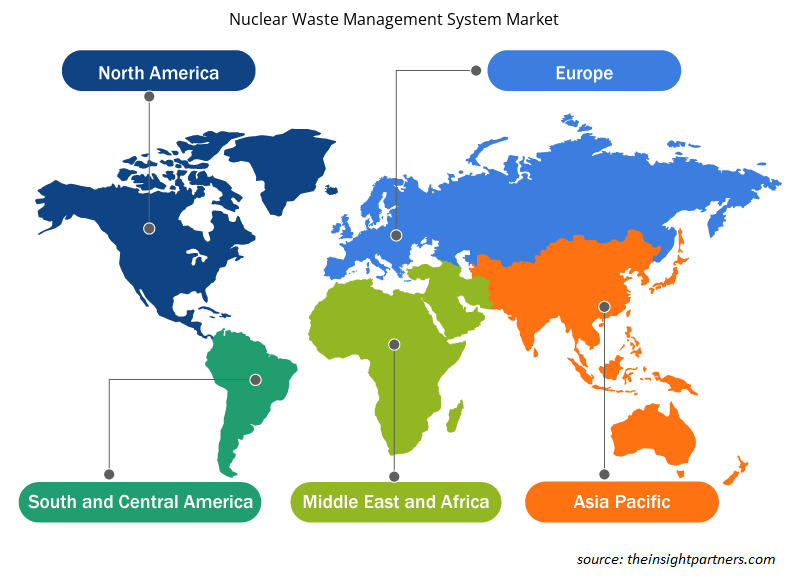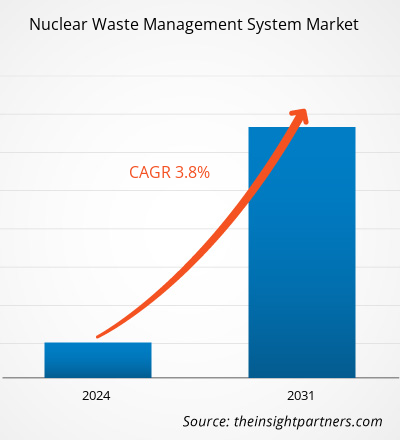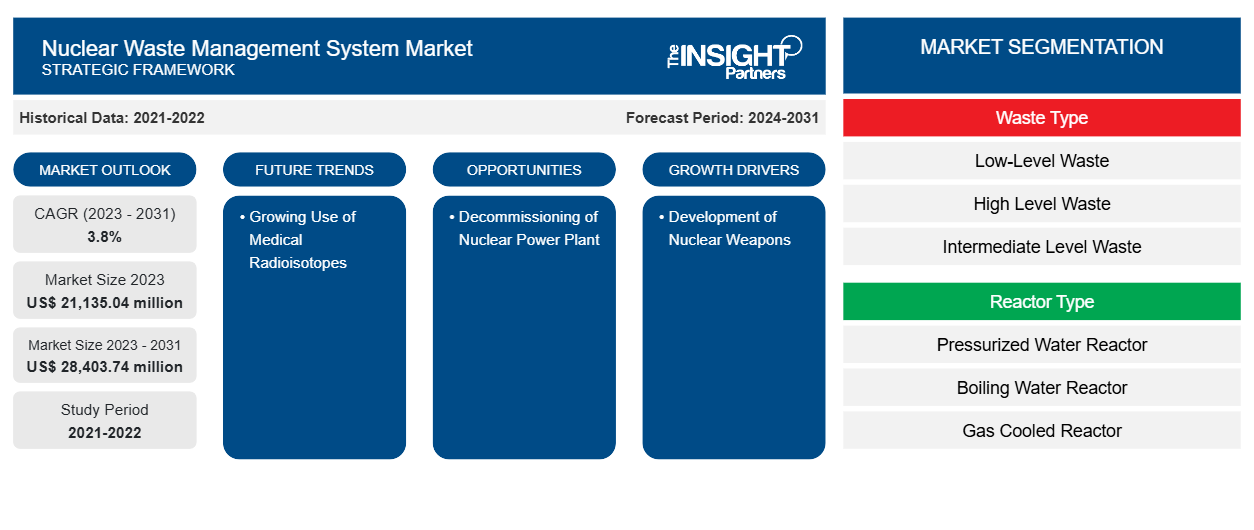من المتوقع أن يصل حجم سوق نظام إدارة النفايات النووية إلى 28403.74 مليون دولار أمريكي بحلول عام 2031 من 21135.04 مليون دولار أمريكي في عام 2023. ومن المتوقع أن يسجل السوق معدل نمو سنوي مركب بنسبة 3.8٪ في الفترة 2023-2031. ومن المرجح أن يظل الطلب على الطاقة مرتفعًا بسبب ارتفاع عدد السكان والتحضر على مستوى العالم إلى جانب التصنيع المتزايد أحد الاتجاهات الرئيسية في سوق نظام إدارة النفايات النووية.
تحليل سوق نظام إدارة النفايات النووية
يشهد سوق نظام إدارة النفايات النووية نموًا كبيرًا بسبب الانتشار المتزايد لمحطات الطاقة النووية في جميع أنحاء العالم بسبب الحاجة المتزايدة إلى الطاقة النظيفة. ومع ذلك، فإن التكلفة العالية لأنظمة إدارة النفايات النووية تحد من نمو السوق. تعد Augean Plc؛ وPerma-Fix Environmental Services, Inc.؛ وSvensk Kärnbränslehantering AB؛ وAnsaldo Energia؛ وUS Ecology, Inc.؛ وVeolia Environmental Services؛ وBechtel Corporation؛ وEnergySolutions؛ وBHI Energy؛ وWaste Control Specialists, LLC من بين اللاعبين الرئيسيين في سوق نظام إدارة النفايات النووية العالمية.
نظرة عامة على سوق نظام إدارة النفايات النووية
أصحاب المصلحة الرئيسيون في سوق نظام إدارة النفايات النووية هم الجهات التنظيمية/ الاستشارية الحكومية ومقدمو الخدمات والمستخدمون النهائيون. تحدد الجهات التنظيمية/ الاستشارية الحكومية اللوائح لكل صناعة وتجعلها إلزامية للمتابعة، نظرًا للمخاوف البيئية المتزايدة. المستخدمون النهائيون لأنظمة إدارة النفايات النووية هم صناعات مختلفة تولد كميات هائلة من النفايات المشعة التي تؤثر على البيئة، مثل محطات الطاقة النووية والأجهزة الطبية الحيوية والأسلحة النووية، من بين أمور أخرى. أصبح استخدام النظائر المشعة في إجراءات التشخيص المختلفة ممارسة شائعة على مستوى العالم. يتم تصنيع النظائر المشعة في المفاعلات النووية أو السيكلوترونات؛ علاوة على ذلك، يلزم تصنيع النظائر الغنية بالنيوترونات وتلك التي تم تطويرها باستخدام الانشطار النووي في المفاعلات. وبالتالي، من المتوقع أن يعزز الاستخدام المتزايد للأدوية النووية في صناعة الرعاية الصحية سوق نظام إدارة النفايات النووية في المستقبل القريب.
قم بتخصيص هذا التقرير ليناسب متطلباتك
ستحصل على تخصيص لأي تقرير - مجانًا - بما في ذلك أجزاء من هذا التقرير، أو تحليل على مستوى الدولة، وحزمة بيانات Excel، بالإضافة إلى الاستفادة من العروض والخصومات الرائعة للشركات الناشئة والجامعات
-
احصل على أهم اتجاهات السوق الرئيسية لهذا التقرير.ستتضمن هذه العينة المجانية تحليلاً للبيانات، بدءًا من اتجاهات السوق وحتى التقديرات والتوقعات.
محركات وفرص سوق نظام إدارة النفايات النووية
تطوير الأسلحة النووية يزيد الطلب على نظام إدارة النفايات النووية
تدفع المخاوف المتزايدة المتعلقة بالأمن القومي الحكومات في جميع أنحاء العالم إلى تخصيص المزيد من الأموال للميزانيات العسكرية. لإجبار دول القوة الدفاعية مثل الولايات المتحدة والصين وروسيا وفرنسا والمملكة المتحدة والهند وإسرائيل وكوريا الجنوبية وإيران على تطوير الأسلحة النووية. أثناء تطوير وتفكيك الأسلحة النووية، يتم توليد ما يكفي من النفايات النووية منخفضة ومتوسطة المستوى. وبالتالي، فإن التطوير المتزايد للأسلحة النووية وتفكيكها يعزز نمو سوق نظام إدارة النفايات النووية.
إيقاف تشغيل محطة الطاقة النووية – فرصة في سوق نظام إدارة النفايات النووية
عادة، تتراوح دورة حياة محطة الطاقة النووية بين 20 و40 عامًا. والآن تقترب العديد من محطات الطاقة النووية من نهاية دورة حياتها. وبالإضافة إلى ذلك، من المتوقع أن تؤدي المخاوف الأمنية بسبب المقاومة السياسية والاجتماعية لإغلاق هذه المحطات إلى تفاقم مشكلة إيقاف تشغيل محطات الطاقة النووية. ومن المتوقع أنه بحلول نهاية عام 2040، سيتم إيقاف تشغيل 75 محطة طاقة نووية و33 مفاعلًا بحثيًا في الأمريكتين، و141 محطة طاقة نووية و64 مفاعلًا بحثيًا في أوروبا، و77 محطة طاقة نووية و17 مفاعلًا بحثيًا في منطقة آسيا والمحيط الهادئ، ومحطتين للطاقة النووية ومفاعلين بحثيين في أفريقيا وأستراليا. وبالتالي، من المتوقع أن يؤدي إيقاف تشغيل محطات الطاقة النووية في جميع أنحاء العالم إلى توليد فرص نمو مربحة للاعبين في سوق نظام إدارة النفايات النووية في السنوات القادمة.
تقرير تحليل تجزئة سوق نظام إدارة النفايات النووية
إن القطاعات الرئيسية التي ساهمت في استخلاص تحليل سوق نظام إدارة النفايات النووية هي نوع النفايات، ونوع المفاعل، وخيارات التخلص منها.
- بناءً على نوع النفايات، تم تقسيم سوق نظام إدارة النفايات النووية إلى نفايات منخفضة المستوى، ونفايات عالية المستوى، ونفايات متوسطة المستوى، وغيرها. احتل قطاع النفايات منخفضة المستوى حصة سوقية أكبر في عام 2023.
- من حيث نوع المفاعل، تم تقسيم السوق إلى مفاعلات الماء المضغوط ومفاعلات الماء المغلي والمفاعلات المبردة بالغاز. هيمنت فئة مفاعلات الماء المضغوط على السوق في عام 2023.
- من حيث خيارات التخلص، تم تقسيم السوق إلى التخلص بالقرب من السطح والتخلص الجيولوجي العميق. وقد هيمنت شريحة التخلص بالقرب من السطح على السوق في عام 2023.
تحليل حصة سوق نظام إدارة النفايات النووية حسب المنطقة الجغرافية
ينقسم النطاق الجغرافي لتقرير سوق نظام إدارة النفايات النووية بشكل أساسي إلى خمس مناطق: أمريكا الشمالية، وآسيا والمحيط الهادئ، وأوروبا، والشرق الأوسط وأفريقيا، وأمريكا الجنوبية/أمريكا الجنوبية والوسطى.
تنقسم سوق أنظمة إدارة النفايات النووية في أمريكا الشمالية إلى الولايات المتحدة وكندا والمكسيك. وتتمتع العديد من الشركات المحلية والدولية بموطئ قدم قوي في هذه المنطقة. وتمتلك الولايات المتحدة حصة كبيرة من سوق أنظمة إدارة النفايات النووية في أمريكا الشمالية، تليها كندا والمكسيك. وتميل أمريكا الشمالية بقوة نحو الطاقة النووية، وتركز الولايات المتحدة وكندا حاليًا على إطالة عمر محطات الطاقة النووية مع استكشاف الخيارات المحتملة لتطوير مفاعلات صغيرة في المنطقة. تمتلك الولايات المتحدة أكبر أسطول من مفاعلات الطاقة النووية في العالم، والتي تلبي حوالي 20٪ من متطلبات الطاقة في البلاد.
علاوة على ذلك، تتمتع أمريكا الشمالية أيضًا بوجود العديد من المرافق البحثية المخصصة لأنشطة البحث والتطوير النووي. كما يعمل قطاع الرعاية الصحية القوي على تغذية نمو الطب النووي والأشعة في أمريكا الشمالية. وبالتالي، فإن كل هذه العوامل تولد فرصًا وفيرة لنمو اللاعبين في سوق نظام إدارة النفايات النووية في المنطقة.
رؤى إقليمية حول سوق نظام إدارة النفايات النووية
لقد قام المحللون في Insight Partners بشرح الاتجاهات والعوامل الإقليمية المؤثرة على سوق نظام إدارة النفايات النووية طوال فترة التوقعات بشكل شامل. يناقش هذا القسم أيضًا قطاعات سوق نظام إدارة النفايات النووية والجغرافيا في جميع أنحاء أمريكا الشمالية وأوروبا ومنطقة آسيا والمحيط الهادئ والشرق الأوسط وأفريقيا وأمريكا الجنوبية والوسطى.

- احصل على البيانات الإقليمية المحددة لسوق نظام إدارة النفايات النووية
نطاق تقرير سوق نظام إدارة النفايات النووية
| سمة التقرير | تفاصيل |
|---|---|
| حجم السوق في عام 2023 | 21,135.04 مليون دولار أمريكي |
| حجم السوق بحلول عام 2031 | 28,403.74 مليون دولار أمريكي |
| معدل النمو السنوي المركب العالمي (2023 - 2031) | 3.8% |
| البيانات التاريخية | 2021-2022 |
| فترة التنبؤ | 2024-2031 |
| القطاعات المغطاة |
حسب نوع النفايات
|
| المناطق والدول المغطاة |
أمريكا الشمالية
|
| قادة السوق وملفات تعريف الشركات الرئيسية |
|
كثافة اللاعبين في السوق: فهم تأثيرها على ديناميكيات الأعمال
يشهد سوق نظام إدارة النفايات النووية نموًا سريعًا، مدفوعًا بالطلب المتزايد من المستخدم النهائي بسبب عوامل مثل تفضيلات المستهلك المتطورة والتقدم التكنولوجي والوعي المتزايد بفوائد المنتج. ومع ارتفاع الطلب، تعمل الشركات على توسيع عروضها والابتكار لتلبية احتياجات المستهلكين والاستفادة من الاتجاهات الناشئة، مما يؤدي إلى زيادة نمو السوق.
تشير كثافة اللاعبين في السوق إلى توزيع الشركات أو المؤسسات العاملة في سوق أو صناعة معينة. وهي تشير إلى عدد المنافسين (اللاعبين في السوق) الموجودين في مساحة سوق معينة نسبة إلى حجمها أو قيمتها السوقية الإجمالية.
الشركات الرئيسية العاملة في سوق نظام إدارة النفايات النووية هي:
- شركة أوجيان المحدودة
- شركة بيرما فيكس للخدمات البيئية
- سفينسك كارنبرانسليهانترينغ AB
- أنسالدو إنيرجيا
- خدمات الجمهورية، المحدودة
- خدمات فيوليا البيئية
إخلاء المسؤولية : الشركات المذكورة أعلاه ليست مرتبة بأي ترتيب معين.

- احصل على نظرة عامة على أهم اللاعبين الرئيسيين في سوق نظام إدارة النفايات النووية
أخبار سوق نظام إدارة النفايات النووية والتطورات الأخيرة
يتم تقييم سوق نظام إدارة النفايات النووية من خلال جمع البيانات النوعية والكمية بعد البحث الأولي والثانوي، والذي يتضمن منشورات الشركات المهمة وبيانات الجمعيات وقواعد البيانات. فيما يلي قائمة بالتطورات في السوق فيما يتعلق بالابتكارات وتوسيع الأعمال والاستراتيجيات:
- في مارس 2022، وقعت شركة Perma-Fix Environmental Services, Inc. وشركة Westinghouse Electric Company عقدًا معًا في ندوات إدارة النفايات لعام 2022 وتخططان لتطوير منشأة معالجة مواد متقدمة في المملكة المتحدة. (المصدر: Perma-Fix Environmental Services, Inc.، بيان صحفي/موقع الشركة على الويب/النشرة الإخبارية)
- في ديسمبر 2023، ارتبطت شركة Veolia Nuclear Solutions بشركة Siteflow لتحسين تصميم ووظائف أنظمتها التي يتم تشغيلها عن بُعد داخل الصناعة النووية وغيرها من البيئات الخطرة. (المصدر: Veolia Nuclear Solutions، بيان صحفي/موقع الشركة على الويب/النشرة الإخبارية)
تقرير سوق نظام إدارة النفايات النووية: التغطية والنتائج المتوقعة
يقدم تقرير "حجم سوق نظام إدارة النفايات النووية والتوقعات (2021-2031)" تحليلاً مفصلاً للسوق يغطي المجالات التالية:
- حجم سوق نظام إدارة النفايات النووية وتوقعاته على المستويات العالمية والإقليمية والوطنية لجميع قطاعات السوق الرئيسية التي يغطيها النطاق
- ديناميكيات السوق مثل المحركات والقيود والفرص الرئيسية
- اتجاهات سوق نظام إدارة النفايات النووية
- تحليل مفصل لـ PEST و SWOT
- تحليل سوق نظام إدارة النفايات النووية يغطي اتجاهات السوق الرئيسية والإطار العالمي والإقليمي والجهات الفاعلة الرئيسية واللوائح والتطورات الأخيرة في السوق
- تحليل صناعة نظام إدارة النفايات النووية والمناظر الطبيعية والمنافسة، بما في ذلك تركيز السوق، وتحليل خريطة الحرارة، واللاعبين البارزين، والتطورات الأخيرة
- ملفات تعريف الشركة التفصيلية
- التحليل التاريخي (سنتان)، سنة الأساس، التوقعات (7 سنوات) مع معدل النمو السنوي المركب
- تحليل PEST و SWOT
- حجم السوق والقيمة / الحجم - عالمي، إقليمي، بلد
- الصناعة والمنافسة
- مجموعة بيانات إكسل
التقارير الحديثة
تقارير ذات صلة
شهادات العملاء
سبب الشراء
- اتخاذ قرارات مدروسة
- فهم ديناميكيات السوق
- تحليل المنافسة
- رؤى العملاء
- توقعات السوق
- تخفيف المخاطر
- التخطيط الاستراتيجي
- مبررات الاستثمار
- تحديد الأسواق الناشئة
- تحسين استراتيجيات التسويق
- تعزيز الكفاءة التشغيلية
- مواكبة التوجهات التنظيمية























 احصل على عينة مجانية ل - سوق نظام إدارة النفايات النووية
احصل على عينة مجانية ل - سوق نظام إدارة النفايات النووية